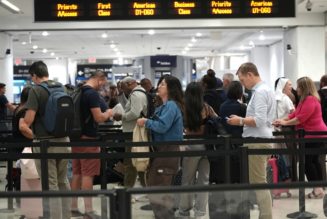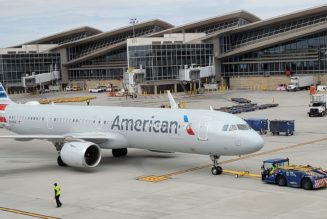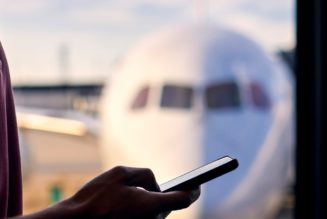
Listen to this article
Produced by ElevenLabs and NOA, News Over Audio, using AI narration.
This article was featured in the One Story to Read Today newsletter. Sign up for it here.
For Thanksgiving, I will be traveling home to western New York on Amtrak. I don’t think anything will go disastrously awry, though I don’t know. In 2019, during a snowstorm, an Amtrak train was stuck for some 36 hours in the mountains of Oregon because of a fallen tree. Earlier this year, on an Amtrak train from Northern Virginia to Sanford, Florida, passengers repeatedly called the police during the train’s 20-hour delay. “For those of you that are calling the police,” the conductor had to announce, “we are not holding you hostage.”
That debacle was caused by a freight train ahead of them, which had crashed into an empty car parked on the tracks in rural South Carolina. Nothing you can do about that. A train just has to wait until whatever’s in front of it is gone. Or it has to plow through it: Just last week, a train on its way through Michigan inadvertently smashed into an unoccupied parked car and then derailed. “If you can imagine it on Amtrak, it will probably happen,” Richard White, a historian at Stanford and the author of Railroaded: The Transcontinentals and the Making of Modern America, told me. He cited another incident from last week, in which certain trains out of New York City were suspended for days because a privately owned parking garage above the tracks had literal holes in it.
Of course, extreme train incidents are rare, and that’s why they make news. No form of transportation is infallible, and severe injury and fatal accidents are exponentially more common with car travel than with train travel. And any form of travel can be delayed by weather or by mechanical issues. The fact is that there is no good way to travel in America. Driving is dangerous, renting a car is a nightmare, and I don’t need to tell you about airplanes. Amtrak isn’t ideal, but it’s nonideal in a unique way. The trains don’t go to enough places; they don’t go often enough; they take too long; they can be more expensive than the faster alternatives. And then sometimes there’s something on the tracks.
Many Americans may be put off by the day-to-day reality of the country’s trains. Just 32 million people took Amtrak in 2019, and a tiny fraction of Thanksgiving travelers this year are expected to take the train. But many Americans still find the idea of train travel very romantic. New train routes generally receive popular support, and Amtrak’s shoot-for-the-moon 2035 plan, released in early 2021, caused national buzz about the future of passenger rail. TikTok travel influencers are thrilled by the views from the observation cars; young meme-makers talk about trains as if they were set down on the face of the Earth by God.
Taking Amtrak, to be clear, is often amazing. I travel on it whenever I can, even if it’s slower (such as to Pittsburgh this summer for a Taylor Swift concert, which took about nine hours from New York City). On a train, everything looks like it’s from the ’80s, because it probably is. But on an airplane, you’re squished and miserable, and everything good costs extra or isn’t allowed. (Amtrak itself has latched onto “no middle seat” as a marketing tactic.) All train seats are huge; I can bring my own bottle of wine if I’m in a sleeper car. Forget driving. What can I do in a car? Not read a book. Not pop up and take a little walk to the café for a turkey sandwich.
The experience may soon get better. President Joe Biden is obsessed with Amtrak and has made extending Amtrak service part of his agenda. The passenger cars, which are 36 years old, on average, are finally getting replaced too. Earlier this month, at an Amtrak maintenance facility in Delaware, Biden designated $16.4 billion for infrastructure repairs, part of the biggest investment in passenger rail since the 19th century. “This is the United States of America,” he said. “There’s not a damn thing we can’t do if we set our mind to it.”
Others might say to keep dreaming. Amtrak has never not had problems. Amtrak was built with problems. (It reportedly lost $500,000 a day in its first year.) Some of these problems are existential: The fact is that many American cities evolved after the invention of the airplane and the car, Eric Jessup, the director of the Freight Policy Transportation Institute, at Washington State University, pointed out. We’re too spread out for trains to get people everywhere they want to go. Other problems are more practical but still severe. Trains are frequently delayed, most often because of freight-train traffic on shared tracks. Last year, the Sunset Limited train from New Orleans to Los Angeles was on time for just 19 percent of trips. And, again, everything is old. Some of the repairs that Biden referenced this month are for a tunnel that was built in the 1800s. (A spokesperson for Amtrak declined to comment on the service’s delays.)
Passenger trains haven’t been good in America in a very long time, so it’s not clear why people have such a soft spot for them. “Few Americans outside the Northeast are old enough to remember days when train travel was the norm,” White told me. “I don’t know if there are enough movies to produce nostalgia.” He couldn’t explain it, he said, but “I think you are right that there is a constituency for trains that extends beyond those people who actually ride them.” He pointed out that people in his home state of California voted to subsidize high-speed-rail construction, even though most people in California probably won’t take those trains. Maybe it’s just that Americans like to have options, whether or not they take advantage of all of them; maybe we, on principle, think we ought to be competing with Europe. Or maybe, as Amtrak put it in a 1993 advertising campaign, “There’s Something About a Train That’s Magic.”
There is something about trains. It’s the forces of nature. It’s physics. It’s wild. Trains are hulky leviathans, and they move—hulking—through the wilderness and the mountains and everywhere else. The technology feels removed from modern life. When it works, it’s amazing. And yet, trains are sensitive. They can get stuck in those mountains for 36 hours! They can tip off of tracks that have been warped by an exceptionally hot day. They can be derailed because perhaps a teenager threw something or because a random abandoned stolen car is sitting on the tracks. “Amtrak—because it has to cross over roads, go through stations, travel long distances—is a system that is particularly vulnerable to idiots,” White told me. “Weird human actions can bring the whole thing to a halt.” But usually, the whole thing doesn’t come to a halt. Usually, you get from Point A to Point B, and you get to see all of the points in between, even if you don’t do it in the time frame you were sold.
In 1971, when the government took over responsibility for passenger-rail service, forming Amtrak, The New York Times speculated that passenger-rail enthusiasts would be “extinct by 1985.” But I’m about to take Amtrak in 2023, and I’m pretty sure I’ll get home … eventually.









